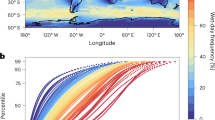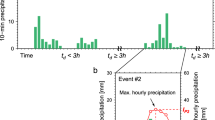Abstract
The mechanisms that cause changes in precipitation, as well as the resulting storm dynamics, under potential future warming remain debated1,2,3. Measured sensitivities of precipitation to temperature variations in the present climate have been used to constrain model predictions4,5, debate precipitation mechanisms2,3 and speculate on future changes to precipitation6 and flooding7. Here, we analyse data sets of precipitation measurements at 6-min resolution from 79 locations throughout Australia, covering a broad range of climate zones, along with sub-daily temperature measurements of varying resolution. We investigate the relationship between temporal patterns of precipitation intensity within storm bursts and temperature variations in the present climate by calculating the scaling of the precipitation fractions within each storm burst. We find that in the present climate, a less uniform temporal pattern of precipitation—more intense peak precipitation and weaker precipitation during less intense times—is found at higher temperatures, regardless of the climatic region and season. We suggest invigorating storm dynamics could be associated with the warming temperatures expected over the course of the twenty-first century, which could lead to increases in the magnitude and frequency of short-duration floods.
This is a preview of subscription content, access via your institution
Access options
Subscribe to this journal
Receive 12 print issues and online access
$259.00 per year
only $21.58 per issue
Buy this article
- Purchase on Springer Link
- Instant access to full article PDF
Prices may be subject to local taxes which are calculated during checkout


Similar content being viewed by others
References
Haerter, J. O. & Berg, P. Unexpected rise in extreme precipitation caused by a shift in rain type? Nature Geosci. 2, 372–373 (2009).
Berg, P., Moseley, C. & Haerter, J. O. Strong increase in convective precipitation in response to higher temperatures. Nature Geosci. 6, 181–185 (2013).
Collins, M. et al. in Climate Change 2013: The Physical Science Basis (eds Stocker, T. et al.) 1029–1136 (IPCC, Cambridge Univ. Press, 2013).
Boucher, O. et al. in Climate Change 2013: The Physical Science Basis (eds Stocker, T. et al.) 571–657 (IPCC, Cambridge Univ. Press, 2013).
Lenderink, G. & van Meijgaard, E. Increase in hourly precipitation extremes beyond expectations from temperature changes. Nature Geosci. 1, 511–514 (2008).
Kirtman, B. et al. in Climate Change 2013: The Physical Science Basis (eds Stocker, T. et al.) 953–1028 (IPCC, Cambridge Univ. Press, 2013).
Westra, S. et al. Future changes to the intensity and frequency of short-duration extreme rainfall. Rev. Geophys. 52, 522–555 (2014).
Alexander, L. V. et al. Global observed changes in daily climate extremes of temperature and precipitation. J. Geophys. Res. 111, D05109 (2006).
Westra, S., Alexander, L. & Zwiers, F. Global increasing trends in annual maximum daily precipitation. J. Clim. 26, 3904–3918 (2013).
Hartmann, D. L. et al. in Climate Change 2013: The Physical Science Basis (eds Stocker, T. et al.) 159–254 (IPCC, Cambridge Univ. Press, 2013).
Trenberth, K. E., Dai, A., Rasmussen, R. M. & Parsons, D. B. The changing character of precipitation. Bull. Am. Meteorol. Soc. 84, 1205–1217 (2003).
Hardwick-Jones, R., Westra, S. & Sharma, A. Observed relationships between extreme sub-daily precipitation, surface temperature, and relative humidity. Geophys. Res. Lett. 37, L22805 (2010).
Utsumi, N., Seto, S., Kanae, S., Maeda, E. E. & Oki, T. Does higher surface temperature intensify extreme precipitation? Geophys. Res. Lett. 38, L16708 (2011).
Wasko, C. & Sharma, A. Quantile regression for investigating scaling of extreme precipitation with temperature. Wat. Resour. Res. 50, 3608–3614 (2014).
Moseley, C., Berg, P. & Haerter, J. O. Probing the precipitation life cycle by iterative rain cell tracking. J. Geophys. Res. 118, 13361–13370 (2013).
Singleton, A. & Toumi, R. Super-Clausius–Clapeyron scaling of rainfall in a model squall line. Q. J. R. Meteorol. Soc. 139, 334–339 (2013).
Loriaux, J. M., Lenderink, G., De Roode, S. R. & Siebesma, a. P. Understanding convective extreme precipitation scaling using observations and an entraining plume model. J. Atmos. Sci. 70, 3641–3655 (2013).
Panthou, G., Mailhot, A., Laurence, E. & Talbot, G. Relationship between surface temperature and extreme rainfalls: A multi-timescale and event-based analysis. J. Hydrometeorol. 15, 1999–2011 (2014).
Westra, S. & Sisson, S. A. Detection of non-stationarity in precipitation extremes using a max-stable process model. J. Hydrol. 406, 119–128 (2011).
Kennedy, M., Turner, L., Canterford, R. & Pearce, H. Temporal Distributions within Rainfall Bursts (Hydrology Report Series 1, Bureau of Meteorology, 1991)
Pilgrim, D. et al. in Australian Rainfall and Runoff—A Guide to Flood Estimation Book 2, Section 2 (The Institution of Engineers, 1997)
Lenderink, G. & van Meijgaard, E. Linking increases in hourly precipitation extremes to atmospheric temperature and moisture changes. Environ. Res. Lett. 5, 025208 (2010).
Tremblay, A. The stratiform and convective components of surface precipitation. J. Atmos. Sci. 62, 1513–1528 (2005).
Ruiz-Leo, A.M., Hernández, E., Queralt, S. & Maqueda, G. Convective and stratiform precipitation trends in the Spanish Mediterranean coast. Atmos. Res. 119, 46–55 (2013).
Berg, P. et al. Seasonal characteristics of the relationship between daily precipitation intensity and surface temperature. J. Geophys. Res. 114, D18102 (2009).
Kirchner, J. W. Catchments as simple dynamical systems: Catchment characterization, rainfall-runoff modeling, and doing hydrology backward. Wat. Resour. Res. 45, W02429 (2009).
Pan, M. & Wood, E. F. Inverse streamflow routing. Hydrol. Earth Syst. Sci. 17, 4577–4588 (2013).
Chow, V., Maidment, D. & Mays, L. Applied Hydrology (McGraw-Hill, 1988).
Brutsaert, W. Hydrology—An Introduction (Cambridge Univ. Press, 2005).
Pilgrim, D. in Australian Rainfall and Runoff—A Guide to Flood Estimation Book 4, Section 1 (The Institution of Engineers, 1997)
Acknowledgements
The authors are grateful for funding support from the Australian Research Council and the Institution of Engineers Australia. The authors wish to thank the Australian Bureau of Meteorology for data provision and support and U. Lall for fruitful conversations.
Author information
Authors and Affiliations
Contributions
C.W. and A.S. conceived the initial idea. C.W. performed the analysis. C.W. and A.S. contributed to the manuscript.
Corresponding author
Ethics declarations
Competing interests
The authors declare no competing financial interests.
Supplementary information
Supplementary Information
Supplementary Information (PDF 14559 kb)
Rights and permissions
About this article
Cite this article
Wasko, C., Sharma, A. Steeper temporal distribution of rain intensity at higher temperatures within Australian storms. Nature Geosci 8, 527–529 (2015). https://doi.org/10.1038/ngeo2456
Received:
Accepted:
Published:
Issue Date:
DOI: https://doi.org/10.1038/ngeo2456
This article is cited by
-
Attribution of the heavy rainfall events leading to severe flooding in Western Europe during July 2021
Climatic Change (2023)
-
Drivers influencing climate of growing cities
Computational Urban Science (2022)
-
Precipitation Extremes and Water Vapor
Current Climate Change Reports (2022)
-
Anthropogenic intensification of short-duration rainfall extremes
Nature Reviews Earth & Environment (2021)
-
Observed response of precipitation intensity to dew point temperature over the contiguous US
Theoretical and Applied Climatology (2021)



